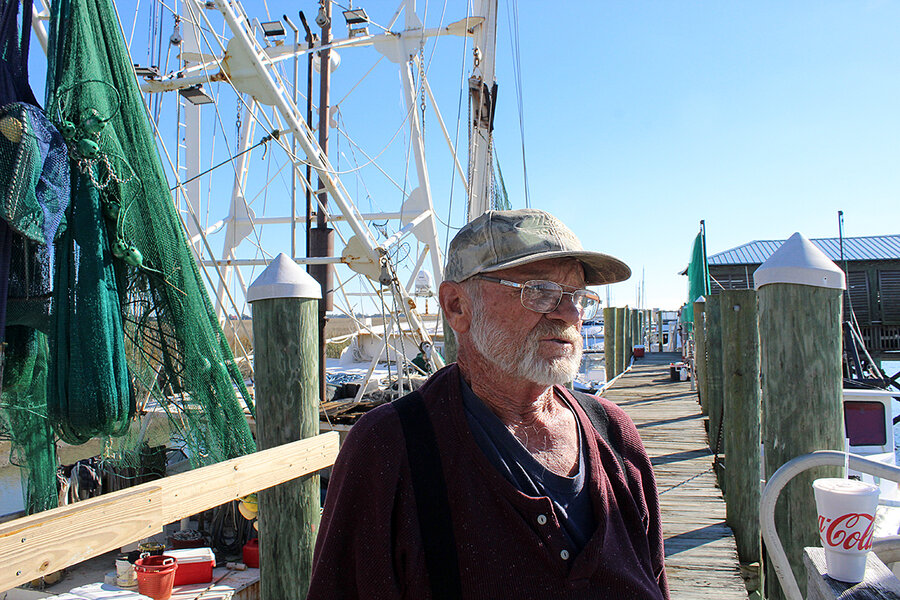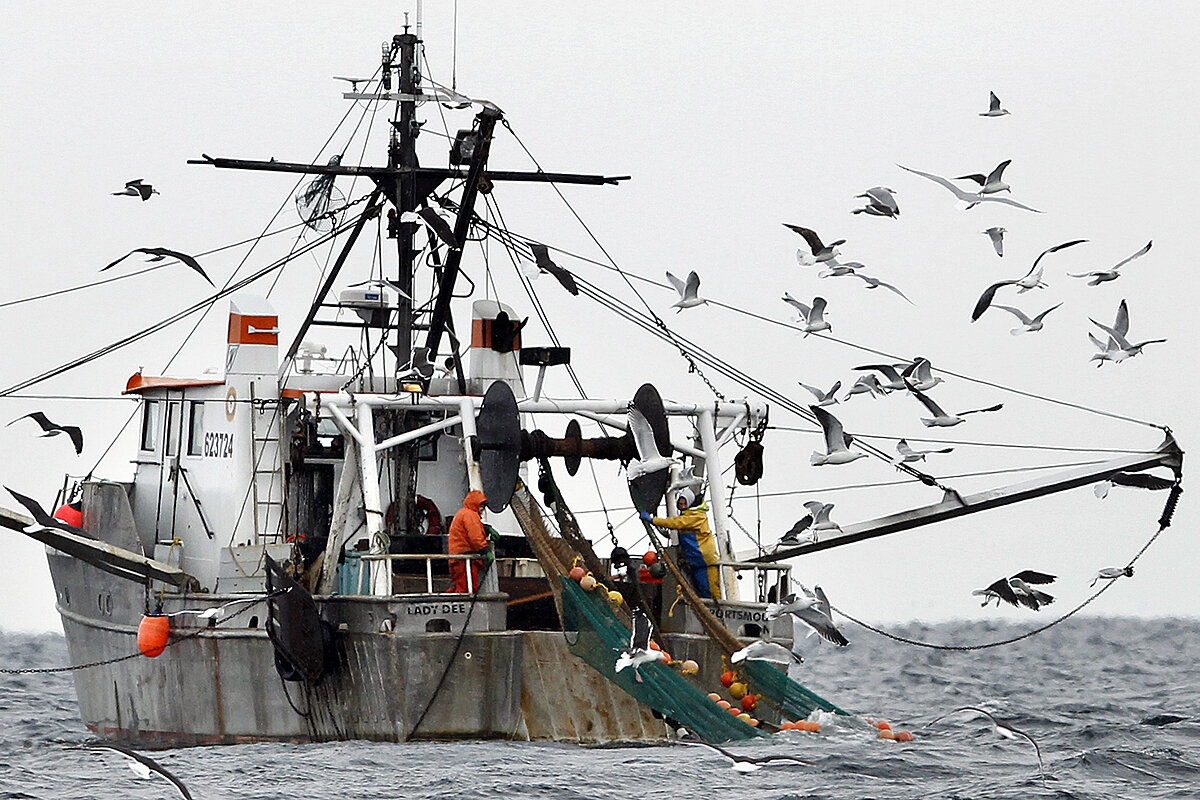From Bubba Gump to bust? American shrimpers face extinction.
Loading...
| Tybee Island, Ga.
On a chilly December morning, the captain of the Miss Patti is ready to throw his lines and go shrimping – well, almost. Brian Jordan’s deckhand is in a foul mood, and it’s no wonder why. Is any of this worth it?
Here on the tiny working waterfront of Tybee Island, Georgia, the hesitancy is logical. Shrimp prices cratered during the past year, and hundreds of boats from Brownsville, Texas, to Harkers Island, North Carolina, remained dockside.
The problem hasn’t been a lack of shrimp or the price of diesel. Instead, freezers across the United States are filled to the gills. A glut of imported shrimp has dropped the price to about half of what shrimp boats received in the 1980s.
Why We Wrote This
American shrimp boats are being made obsolete by foreign shrimp farms, many with dubious practices. To survive, boat captains will need to reinvent themselves as innovators and entrepreneurs.
At stake is the livelihood of Mr. Jordan and shrimpers like him nationwide. They can’t compete with overseas rivals who raise and harvest shrimp in lower-cost “aquaculture’’ farms. There, baby shrimp essential to the marine life food chain are raised in artificial saltwater ponds, then harvested in bulk and sold for reduced prices around the world.
Because shrimp is the most valuable marine product traded in the world today – growing from a $10.6 billion industry in 2005 to over $60 billion in 2022 – the shift is consequential on many fronts. The practice is generating substantial income for developing countries such as Thailand, Indonesia, India, Vietnam, Brazil, Ecuador, and Bangladesh.
But the trend, some experts say, hurts more than just seafaring boaters like Mr. Jordan: Much of the overseas aquaculture industry is damaging to the environment, they say.
The average annual per capita consumption of shrimp in the U.S. is now at 4 pounds.
According to the World Wildlife Fund, it takes three to six months to raise market-sized shrimp, with many farmers growing two to three crops per year. Pollution from these farms, most of which are in tropical climates, is substantial, dumping organic waste, chemicals, and antibiotics into groundwater and estuaries, and salt into agricultural land. At the same time, the reality is that aquaculture is likely here to stay, and can be done in more responsible ways. The U.S. shrimping industry that survives will likely look quite different from what has existed for generations. The question is how shrimpers will adapt and innovate to change with the times.
“You need to be both a farmer and entrepreneur if you want to succeed,” says Frank Asche, a natural resource economist at the University of Florida in Gainesville. “And in some sense, that’s the challenge of the U.S. shrimp fleet.”
“Implied fraud”
For Mr. Jordan, the shrimp market of today is what he refers to as “implied fraud.”
“The consumer sees a picture of a shrimp boat and some nets hanging there, and they assume that the shrimp are from America,” he says. “And for the most part, they are not.”
The growth of aquaculture has more than halved the U.S. shrimp fleet since the 1990s. Today, less than 10% of the domestic supply is wild-caught U.S. shrimp. And the trend hasn’t hit just shrimpers. Fisheries from salmon to catfish have been affected as aquaculture farmers fine-tune their processes, products, and prices.
Concerns about global aquaculture are varied. There is documented use of slave labor and the application of antibiotics and herbicides to farm ponds. Aquaculture operations have also been known to clear-cut mangrove swamps – the nurseries of many ocean species – to make room for shrimp ponds.
“It’s very difficult to know where your shrimp is coming from,” Ryan Bigelow, of the initiative Seafood Watch, told the FoodPrint blog.
But the industry is also fragmented. Products grown more ethically tend to be sold in Europe and the U.S., while products that don’t meet those standards are sold in less-advanced economies where aquaculture has boomed, says Professor Asche.
“That is putting on that slow pressure for the wild fishers,” he says. “That’s the main driving force.”
And it’s not just American shrimp boats falling prey. American attempts at aquaculture are struggling to compete, too.
Some 100 miles from the Gulf of Mexico, David Teichert-Coddington grows shrimp in two dozen ponds drawn from the Eutaw Reservoir in Boligee, Alabama. The water is saline enough, when amended with other minerals, to grow shrimp and grow them fast.
He can say his shrimp are U.S. grown. But that market, too, is flooded. Meanwhile, Ecuadorian shrimp are clean, well-packaged, and tasty, he says. As a result, Mr. Teichert-Coddington may leave his ponds empty next year.
“What you run into is, ‘Yeah, I like the story and the product, I’d love to buy it, but what’s the price?’” says the former university professor, who started Greene Prairie Aquafarm 23 years ago. “That it’s chemical-free and a USA product almost always just doesn’t matter. Their pocketbook talks first.”
Glimpses of the future
Mr. Teichert-Coddington is in the same boat as Tommy Faulkner, another Tybee Island captain. To Mr. Faulkner, reframing the industry from fiercely independent seafarers to savvier domestic resource harvesters is part of a necessary shift. That could unlock federal aid.
“At the end of the day, my boat is a sea tractor and we’re farmers who go out and harvest a crop,” he says.
“There’s no one solution,” adds Paige Morrison, executive director of the Georgia Commercial Fisherman’s Association in Savannah. “It’s going to take legislation, it’s going to take support and awareness and education, it’s going to take a new marketing system – a whole new business model.”
But there are potential ways forward.
The World Wildlife Fund, for one, is working to develop enforceable standards that reduce negative environmental and social impacts and ensure quality and safety, while improving aquaculture practices through tech innovations like forensic analysis of farmed products. The group is also working to encourage practices that help traditional shrimpers still make a living.
And a new red snapper fishery in the Gulf of Mexico, for example, has found success with new premium markets, safer and more professional methods, and good prices – albeit with fewer boats.
“I think what we’re looking at is a system in transition and where it is going depends,” says Phil Loring, author of “Finding Our Niche: Toward a Restorative Human Ecology,” and a food systems expert at The Nature Conservancy. “With the right nudges, it could be really something that features the character of local and regional food, supports a blue-collar culture, and supports working waterfronts that people like to see.”
Editor’s note: In a sentence about price declines, a time reference has been corrected to encompass 2023.







